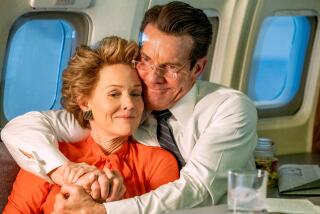ERASING THE STEREOTYPE OF SOVIETS
Nothing lasts like a stereotype.
Women from Boston had been looking at a big TV screen showing satellite pictures of women from Leningrad, and vice versa. âIâm noticing,â a Boston woman told her Soviet counterparts, âthat a lot of you look kind of sad and depressed.â
The American woman had seen only what she wanted to see, for in reality the pictures from Leningrad contained as many happy faces as the pictures from Boston.
That little episode was the most revealing during Saturdayâs âCitizens Summit II,â a one-hour program, seen here on KNBC Channel 4, that linked 200 American and 200 Soviet women via satellite.
It appears that global sisterhood is not imminent.
Moderators for the occasionally testy dialogue were Phil Donahue in Boston and Vladimir Posner in Leningrad. The producers were the Documentary Guild, the Hearst Television Group and the Gosteleradio (Soviet broadcasting), in association with Multimedia Entertainment.
Many Americans do believe that the average Soviet is miserable and longs to live in Topeka, Kan.
âLook,â American documentary producer Ira Miskin said by phone from Atlanta, âI believe in Capitalism. I believe it will win. I donât believe in Socialism. I donât believe in Communism. But they (the Soviets) do.â
Miskin is executive producer of âPortrait of the World.â Thatâs a new documentary series from Atlanta cable-superstation WTBS, set to premiere nationally in November, 1987, with an ambitious seven-hour account of the Soviet Union.
Miskin has spent several months in the Soviet Union researching and negotiating in preparation for Sundayâs production start. And heâs met many average citizens.
âThe majority of people I spoke to--and Iâm talking about the ordinary people Iâd meet in the street and cafes and places like that--were pleased with their lives,â he said. âTotally happy? No. Do they want more than they have? Yes. But theyâre basically pleased. Itâs hard for Americans to adapt to that reality.â
Itâs also hard to convince many Americans that the Soviets suspect our leaders as much as we do theirs--a la ABCâs coming âAmerikaâ miniseries depicting Soviet occupation of the United States.
Miskin was in the Soviet Union in 1985, for example, when a cancerous tumor was removed from President Reaganâs intestine. Many Soviets were convinced that Reagan was dying, Miskin said, âand they wondered that if he were in his last days, would he be more prone to push the button?â
The documentary on the Soviets is another bold, extraordinary, surprising, noisy chapter in the colorful career of Atlanta broadcasting magnate Ted Turner, whose Turner Broadcasting Co. has become an industry pioneer.
Turnerâs company owns WTBS as well as Cable News Network. The documentary was part of his multilevel deal with the Soviets that included his Goodwill Games, a Soviet co-produced Moscow mini-Olympics that will be beamed to a network of stations, including KTLA Channel 5 in Los Angeles, starting Saturday. As part of the same deal, the WTBSâ âPortrait of Americaâ series will be shown in the Soviet Union.
Miskinâs production team is from Englandâs Antelope Films. WTBS has editorial control over the Soviet series, with the editing and narration to come in the United States.
âBut the Soviets hold the key to the door,â Miskin said. âWe gave them a laundry list of locations and people we wanted to meet and then we negotiated. Itâs the Soviet way.â
Included in the WTBS preparatory was a two-month, 25,000-mile research trip with representatives of state-run Gosteleradio. Then the WTBS people wrote treatments for each of the seven programs, which were pored over by the Soviets.
âWe spent an extraordinary five days, going over them paragraph by paragraph,â Miskin said. âThey were tough. They wanted to know why we wanted to go to each location.â
The Soviets rejected one site because it was near military installations. And when the WTBS people omitted Armenia from the program, the Soviets produced a list of people to interview there.
Werenât they handpicked?
âYou have to understand that everyone you meet (for an interview) is in some way handpicked,â Miskin said. âYou canât believe that you can just go anywhere and pick anyone you want and the Soviets donât know it. But on a personal level, things happen, and you can sometimes turn things another way.â
A big omission: apparently unshown will be the Sovietsâ most sinister side. That includes the Kremlinâs shoddy human rights record, suppression of minority dissidents and prohibition of most Jews and others from emigrating. After all, there are some sad and depressed people in the Soviet Union.
âItâs just not the intention of these films to deal with dissidents,â Miskin insisted. âYou cannot deal with these things in an offhanded way. I can see going there another time and getting another kind of reality. But it just didnât fit into what we were doing this time.â
Miskin will begin production at a time when communications between the the Soviet Union and the West--if not trust--are at a soaring high.
Look at the examples: increasing spacebridges like âCitizens Summit II,â NBC co-producing âPeter the Greatâ with the Soviets, Kremlin spokesman Posnerâs recent American TV tour, the Goodwill Games, the BBCâs âComradesâ documentary series (premiering on the Public Broadcasting Service Tuesday) and now Miskinâs program.
Turner seems to want the Goodwill Games and the Soviet documentary to lessen tensions between the two super powers.
âTed feels that if people on a simple level are less frightened and easier to talk to, then negotiations on complex issues are easier,â Miskin said.
Armed with a budget of between $2.5 million and $3 million and a mandate from Turner to show Soviet life âthrough the eyes of the people,â Miskin will film in 13 of 15 Soviet republics, wrapping up production next February.
Heâll even go to Siberia in the winter.
âYes, itâs a frozen wasteland,â he said. âYes, itâs 40 degrees below zero. But the Soviet Union also has lots of economic hopes for the future there. Theyâre paying young folks double salary to go out there and spend years building a city or a nuclear reactor or oil fields. There are towns out there with 100,000 people that eight years ago were built from the ground up. Things are changing. We went to a disco there where young people were dancing to Willie Nelson.â
The last of the seven programs will speculate about the Soviet Unionâs future. âWe see the Soviet Union as in a second revolution, a consumer revolution, and I thought the Soviets would balk at us saying that, but they didnât,â Miskin said.
âThe consumers have lived through 50 or 60 years of building and now the man in the street is saying, âOK, weâve rebuilt the country, now Iâd like a pair of brown shoes, size 10, and maybe a new car. How about all the things a super power should be able to give its people?â â
The stereotype fades.
More to Read
The complete guide to home viewing
Get Screen Gab for everything about the TV shows and streaming movies everyoneâs talking about.
You may occasionally receive promotional content from the Los Angeles Times.






